It can happen that the display output port or connector on your graphics card or video adapter does not match the ones on the monitor. For example, your graphics card comes with DVI and VGA ports, but the monitor has DisplayPort and HDMI ports. In such cases, you need some kind of display adapter or converter cable that can connect your graphics output to the monitor so that you have display output on your screen. You can also use these display converter cables and adapters to connect your laptop output to the monitor or projector. Display adapters and converter cables do work pretty well, but in some cases, they may face compatibility issues and fail to work with some devices or hardware. Also, some of them have some kind of limitations, which can restrict their usage. These display converter adapters and cables are available in different lengths, and quality, and some can work differently than others.
Digital and Analog Signals
DisplayPort, HDMI, and DVI are digital ports/connectors and carry or transmit digital signals while VGA connector or port carries or sends analog signals. In some cases, the conversion between digital ports or connectors is pretty straightforward and can be done by matching and connecting the corresponding wires from one connector to another. On the other hand, the conversion of digital signals to analog signals or vice versa is a complicated process because it involves some kind of circuitry and IC chip that converts the digital signals to analog or vice versa.
Active vs. Passive Adapters
The display adapters or converters that convert one signal to another without any extra power and active circuitry involved are called passive adapters or converters. It can be done by passing the same video signal from the source port to the destination port without any signal processing that involves decoding, encoding, and retransmission of the signal. However, passive adapters may contain a voltage level converter IC chip to convert the voltage level of the source port to be compatible with the output port. For example, DisplayPort’s native voltage is 3.3V, but DVI and HDMI work at 5V, so the 3.3V voltage signals must be converted to 5V signals for DVI and HDMI devices to work.
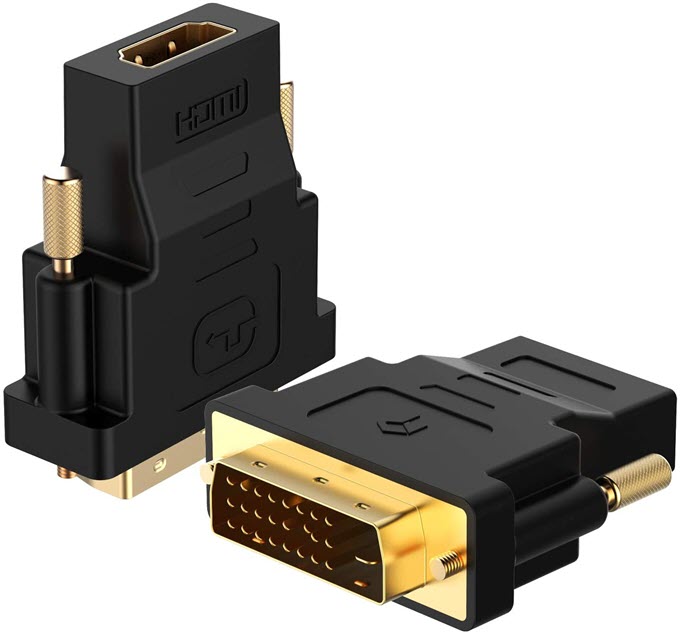
Passive Adapters
Adapters that use some IC chip and active circuitry for processing and conversion of one signal to another are called active adapters or converters. The chip and active circuitry decode, process, and retransmits the signal in the proper form for the input port. It is done to ensure maximum compatibility with older ports with power limitations, to boost the signal to deliver higher resolution and to support multiple monitors or devices, e.g., Active DisplayPort to HDMI Adapter. Active adapters are costlier than passive adapters, and some of the active adapters or converters do require external power, which can be provided through USB port or adapter. Conversion of signals from digital to analog port or vice versa can only be done by active adapters. On the other hand, the transformation of digital signals from one connector to another can be done passively or actively depending on the adapter or port type. Below you can see an active adapter from the outside and inside.
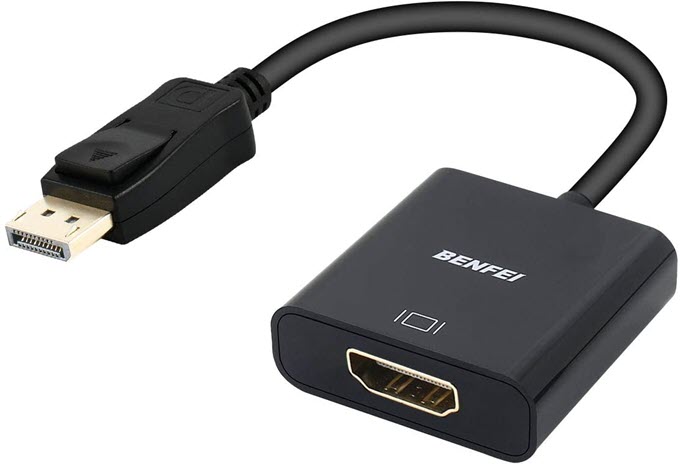
Active Adapter
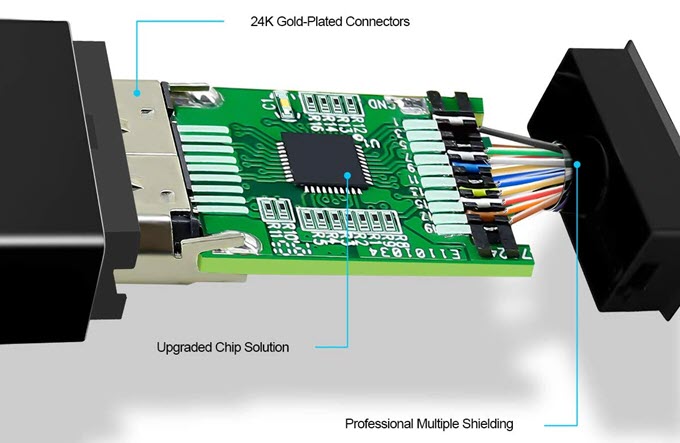
Inside an Active Adapter
Adapter vs. Cable
Well, there is a small difference between adapters and cables that are used for the conversion of one display signal to another. An adapter is shorter in length and has a female connector at the output end. It may also contain an external power port for the active conversion of the signal. On the other hand, a cable is longer and generally has male connectors at both ends. The cable can be used directly with the output and input source.
Unidirectional vs. Bi-Directional
Most of these display converters are unidirectional, which means they are one-way converters. For example, a DisplayPort to HDMI adapter converts DisplayPort signal to HDMI and cannot be used to convert DVI to HDMI signal. The only bidirectional converter cable is the HDMI to DVI, which can also be used for DVI to HDMI conversion.
Do these Display Converters/Adapters Work & their Limitations
Generally, these converters work fine, and rarely you may face compatibility issues with your computer or monitor. Some converters are limited to lower display resolution and refresh rates, and they won’t go beyond it even if the monitor and graphics card support higher resolution. For example, a converter can only support up to FHD or 1080p resolution@60Hz even if the monitor and graphics cards can output higher resolution or refresh rate. All these display converter cables or adapters are Plug and Play, which means you don’t need to install any drivers or software for them to work.
How to Find the best display converter cable or adapter?
You can identify a good display adapter or converter by looking at the quality of connectors, thickness of the cable, and wire material. A good converter has a thick cable with internal shielding and uses copper wires for data or signal transmission. Some of the adapter cable connectors are gold plated to prevent them from any kind of corrosion or oxidation. The construction quality of the connectors should be sturdy, and they should be made from good quality plastic. If you are buying an adapter or connector cable online, which most of you do, then read the reviews about the converter or adapter to check whether it works properly and is there any problem or issue associated with it. Choosing between active and passive adapters is a matter of personal choice and requirement, but a passive cable is generally more reliable than an active one. Some brands that offer good display converters cables or adapters are AmazonBasics, Cable Matters, CableCreation, StarTech.com, Moread, and Benfei.
DisplayPort Converters
Below are the display adapters or cables to convert the DisplayPort signal to other types. It should be noted that you can use passive DisplayPort adapters or cables only if your DisplayPort port supports DisplayPort Dual-Mode (DP++); otherwise, you have to use Active adapters for older DisplayPort port (DisplayPort 1.0). In DisplayPort Dual-Mode (DP++), if the device detects an HDMI/DVI adapter or device at the other end, then the DisplayPort source, i.e., GPU will automatically transmit TMDS signals for HDMI or DVI port or devices (monitor or projector).
DisplayPort to HDMI Adapter/Cable – This type of adapter/cable converts DisplayPort signal to HDMI signal. It means it takes DisplayPort signal as input from the graphics card or adapter and outputs the HDMI signal to the monitor. Most of these converter cables are passive and have male DisplayPort and HDMI connectors at the ends. You can also find an active DisplayPort to HDMI adapter for conversion from DisplayPort to HDMI signal. Both active and passive DisplayPort to HDMI Cables/Adapters can transfer audio too and can support high resolutions up to 4K, depending on the adapter/cable quality and capability.
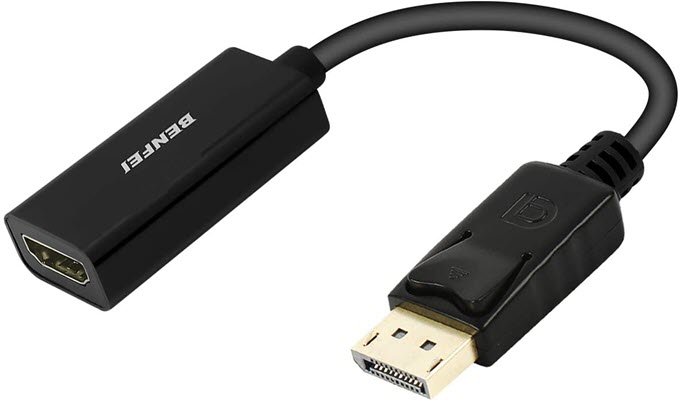
DisplayPort to HDMI Adapter
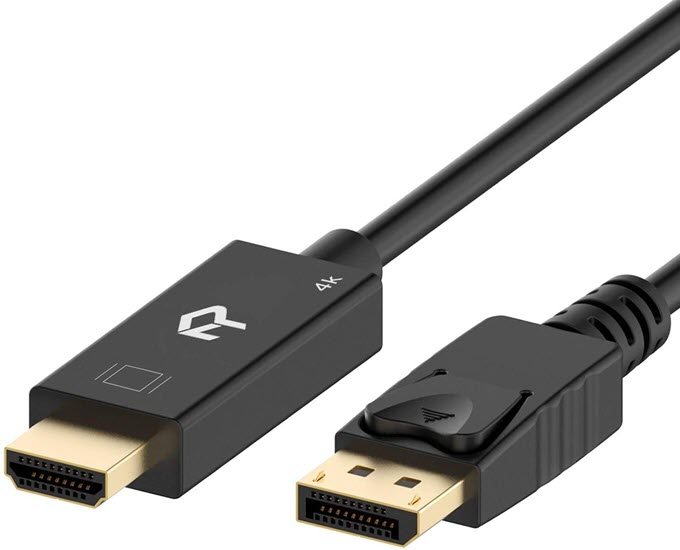
DisplayPort to HDMI Cable
Note: DisplayPort uses the LVDS signal protocol, which is not compatible with the TMDS signal used by HDMI or DVI. LVDS stands for Low-voltage differential signaling, and TMDS means Transition-minimized differential signaling.
DisplayPort to HDMI Cables/Adapters you can Buy:
- Rankie DisplayPort to HDMI Cable
- AmazonBasics DisplayPort to HDMI Cable
- Avacon DisplayPort to HDMI Cable
- STARWARE DisplayPort to HDMI Adapter (Compact)
- Benfei DisplayPort to HDMI Adapter
- AmazonBasics Mini DisplayPort to HDMI Display Adapter Cable
- Cable Matters Active DisplayPort to HDMI Adapter
- BENFEI Active DisplayPort to HDMI 4K Adapter
- CableCreation Active DP to HDMI Cable
DisplayPort to DVI Adapter/Cable – It converts DisplayPort signal from graphics card or display adapter to DVI signal for monitor or projector having DVI port. These types of cables or adapters come in both passive and active forms. The DisplayPort to DVI adapters/cables can transmit single-link DVI only that limits the maximum resolution to 1920 x 1200@60Hz.
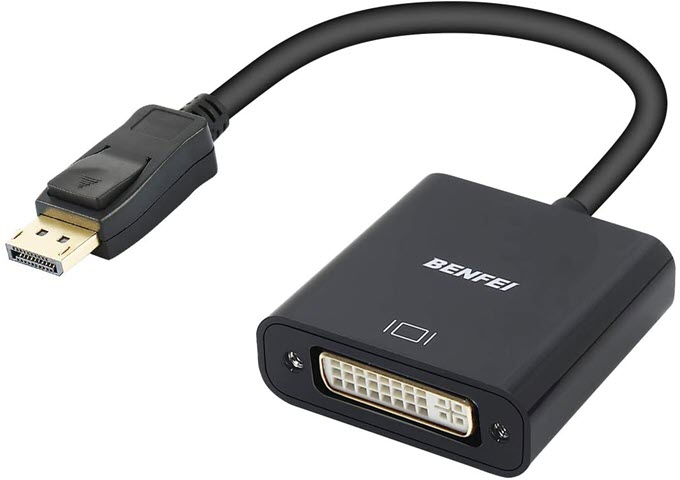
DisplayPort to DVI Adapter
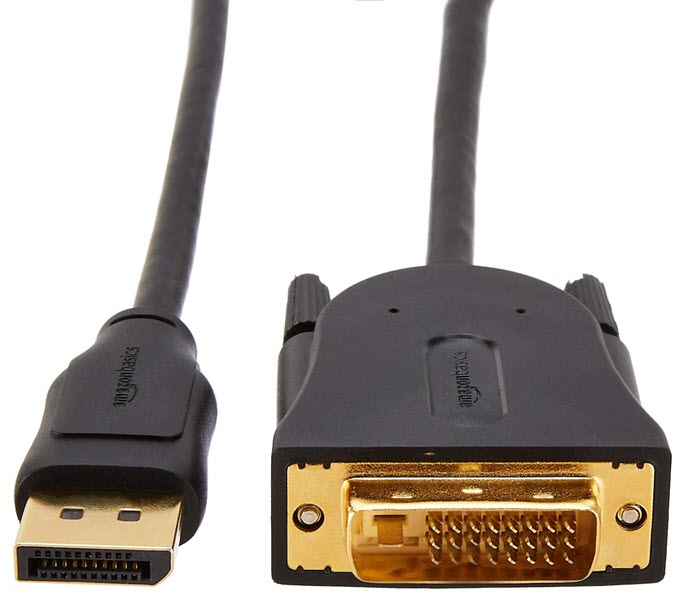
DisplayPort to DVI Cable
DisplayPort to DVI Adapters/Cables you can Buy:
- Benfei DisplayPort to DVI Cable
- AmazonBasics DisplayPort to DVI Cable
- Moread DisplayPort to DVI Adapter
- Rankie DisplayPort to DVI Cable
- Benfei DisplayPort to DVI Adapter
- StarTech.com DisplayPort to DVI Adapter Dual-Link (Active)
- CableCreation Active DisplayPort to DVI Cable
- Cable Matters Active DisplayPort to DVI Adapter
- CableCreation Active DisplayPort to DVI Adapter
DisplayPort to VGA Adapter/Cable – This type of adapter/Cable converts DisplayPort digital signal to VGA signal, which is analog. The maximum resolution supported by these adapters is 1920×1200/1080@60Hz. The conversion of the digital signal to an analog signal can be done only by the use of external signal processing machinery, so all these adapters/cables are technically active.
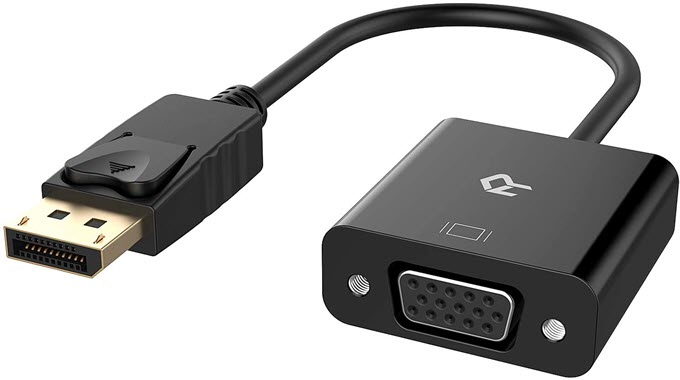
DisplayPort to VGA Adapter
DisplayPort to VGA Adapter/Cables you can Buy:
- Benfei DisplayPort to VGA Cable
- Moread DisplayPort to VGA Adapter
- Rankie DisplayPort to VGA Adapter
- CableCreation DisplayPort to VGA Cable
- StarTech.com DisplayPort To VGA Adapter
- Cable Matters DisplayPort to VGA Adapter
- Cable Matters DisplayPort to VGA Cable
- AmazonBasics Mini DisplayPort to VGA Adapter (Apple Compatible)
HDMI Converters
These display adapters or cables convert HDMI signals to other types.
HDMI to DisplayPort Adapter – The conversion of HDMI signals to DisplayPort signals can only be carried out actively using an active adapter. It is because, unlike DisplayPort, HDMI does not have DisplayPort++ like functionality, and the signals from HDMI source have to be converted by an IC chip to DisplayPort signals. HDMI to DisplayPort active adapters also require external power via USB cable and can support up to 4K resolution. These adapters have male HDMI connectors at one end, along with a male USB connector and a female DisplayPort connector or port at the other end.
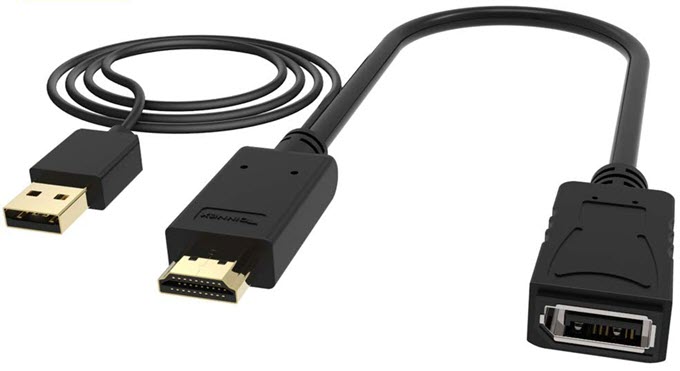
HDMI to DisplayPort Adapter
HDMI to DisplayPort Adapters you can Buy:
- FOINNEX HDMI to DisplayPort Adapter
- Benfei HDMI to DisplayPort Adapter
- QGeeM HDMI to DisplayPort Adapter
- FOINNEX HDMI to DisplayPort Cable Adapter
HDMI to DVI Cable/Adapter – HDMI and DVI signals are electrically compatible, and the conversion can be done passively without the need for any chip or circuitry. The HDMI to DVI cables or adapters is bidirectional, which means they can convert signals from DVI to HDMI also. The HDMI to DVI converters can transmit single-link DVI only, which means the maximum resolution is limited to 1920 x 1200@60Hz.
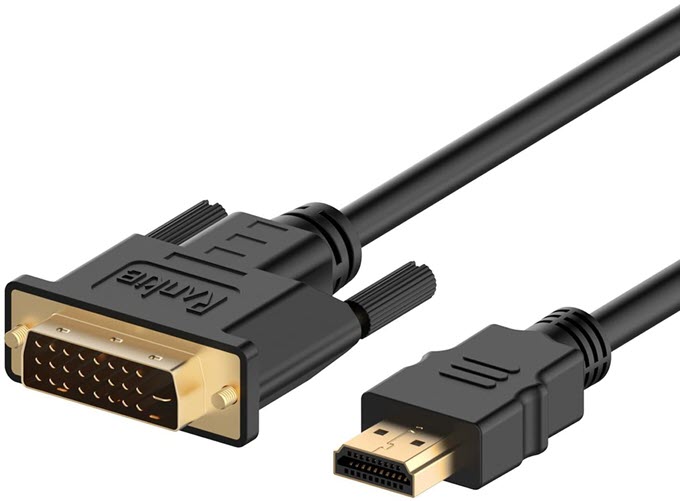
HDMI to DVI Cable

DVI to HDMI Adapter
HDMI to DVI Cables/Adapters you can Buy:
- Rankie HDMI to DVI Adapter
- AmazonBasics HDMI to DVI Cable
- Rankie HDMI to DVI Cable
- Benfei HDM to DVI Cable
- Benfei HDMI to DVI Adapter
- CableCreation HDMI to DVI Cable
- CableCreation HDMI to DVI Adapter
- AmazonBasics HDMI to DVI-D Adapter
HDMI to VGA Adapter/Cable – These are active adapters/cables and convert HDMI signal to VGA signal using an IC chip or integrated circuit. The maximum resolution supported is 1920 x 1080@60Hz, and the adapters come with a male HDMI connector at one end and a female VGA connector or port at the other. An HDMI to VGA cable has a male HDMI connector at one end and male VGA connector at the other.
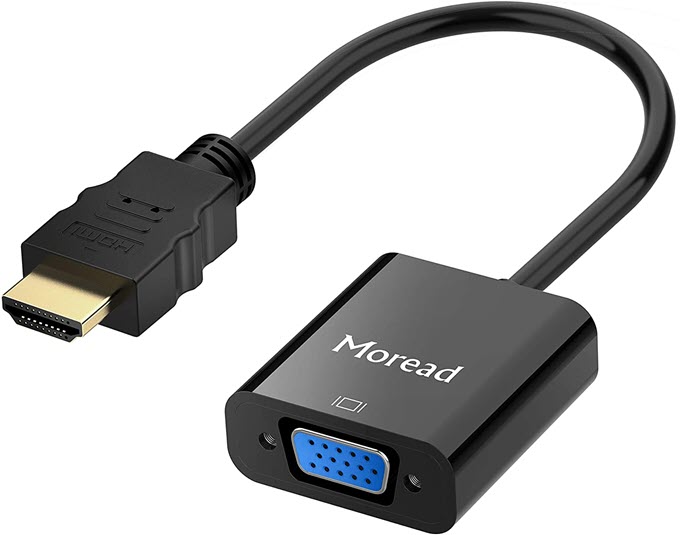
HDMI to VGA Adapter

HDMI to VGA Cable
HDMI to VGA Adapters/Cables you can Buy:
DVI Converters
These display adapters or cables convert DVI signals to other types.
DVI to DisplayPort Adapter – Converts DVI signal to DisplayPort signal. The adapter for such conversion is active and uses external power via a USB port. The maximum resolution supported by such adapters is 1920 x 1200@60Hz, which is the same as single-link DVI. There are very few adapters available that converts DVI to DisplayPort signal, and it has a male DVI connector at one end along with and female DisplayPort connector at the other with a male USB port for power.
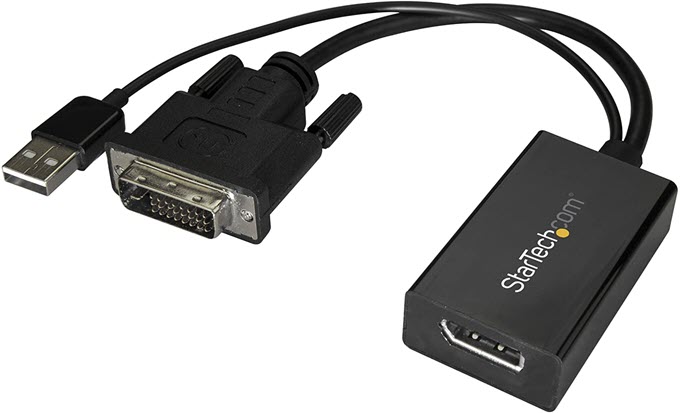
DVI to DisplayPort Adapter
DVI to DisplayPort Adapter you can Buy:
DVI to HDMI cable – DVI to HDMI cables are the same as the HDMI to DVI Cables or adapters because they are bi-directional. The maximum resolution supported by them is 1920 x 1200@60Hz.

DVI to HDMI Cable
DVI to HDMI Cables/Adapters you can Buy:
- Rankie DVI to HDMI Adapter
- AmazonBasics HDMI to DVI Cable
- Rankie HDMI to DVI Cable
- Benfei HDM to DVI Cable
- Benfei DVI to HDMI Adapter
- CableCreation DVI to HDMI Cable
- CableCreation DVI to HDMI Adapter
- AmazonBasics HDMI to DVI-D Adapter
DVI to VGA Adapter Cable – There are three types of DVI connectors, DVI-A, DVI-I, and DVI-D, and they use different adapters for conversion into VGA. DVI-A transmits only analog signals, and DVI-I transmits both analog and digital signals. They use passive DVI-I to VGA adapters or cables for conversion to VGA as the four extra pins in the DVI-I/DVI-A port provide the analog signal. On the other hand, DVI-D outputs only digital signals and requires an active adapter for conversion to VGA signals. The maximum resolution supported by active and passive DVI adapters is 1920×1080@60Hz.
Below you can see the differences between DVI-A, DVI-I, and DVI-D connectors. DVI-I has four extra pins that carry an analog signal, which is absent in the DVI-D connector.
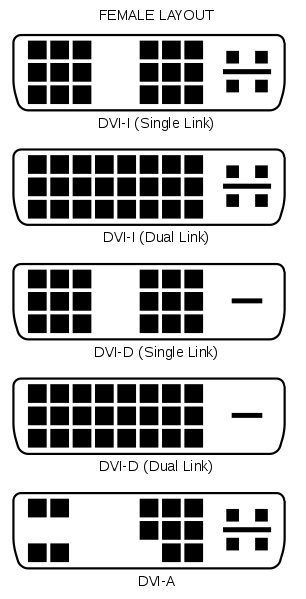
DVI-I to VGA Adapter
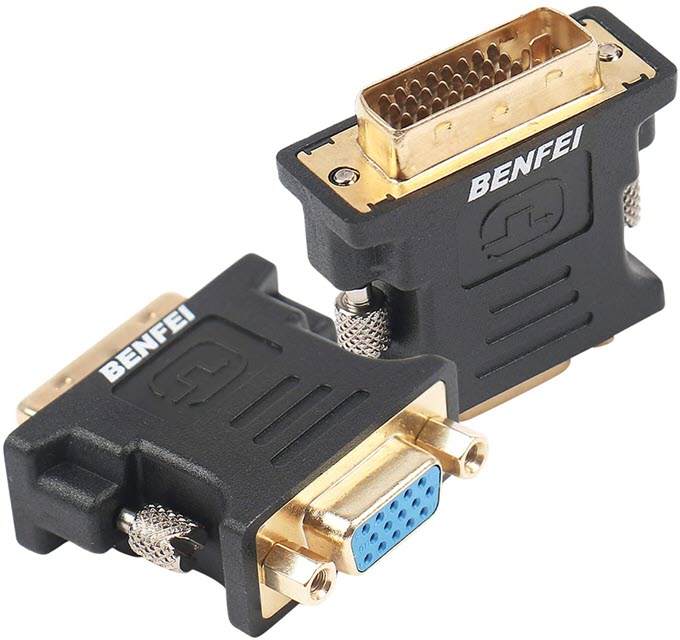
DVI-I to VGA Adapter
DVI-D to VGA Adapter
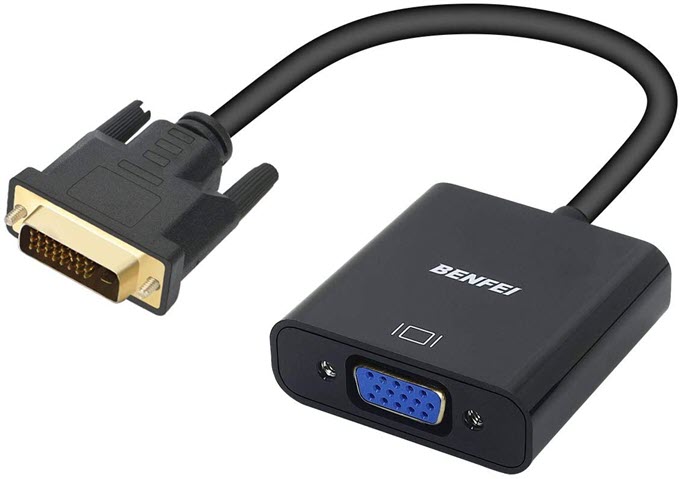
DVI to VGA Adapter
DVI-I to VGA Adapters/Cables you can Buy:
- UGREEN DVI-I to VGA Adapter
- UGREEN DVI-I to VGA Cable
- BENFEI DVI-I to VGA Adapter
- AmazonBasics DVI-I to VGA Cable
- Cable Matters DVI-I to VGA Cable
DVI-D to VGA Adapters you can Buy:
- Benfei DVI-D to VGA Adapter
- CABLEDECONN DVI-D to VGA Cable
- CABLEDECONN DVI-D to VGA Flat Cable Adapter
VGA Converters
Conversion of VGA analog signals to other digital signals is a bit complex, and there are almost no adapters available for it. However, you can find an active VGA to HDMI adapter and it uses additional power from the USB port. Some adapters may contain a 3.5mm aux jack for transmission of audio to the HDMI port using the 3.5mm audio cable from the computer with VGA output.
VGA to HDMI Adapter – An active adapter that converts VGA signal to HDMI signal and uses external power from the USB port. The maximum resolution supported by such adapters is 1920 x 1080 @ 60Hz. Below you can see types of VGA to HDMI Adapters.
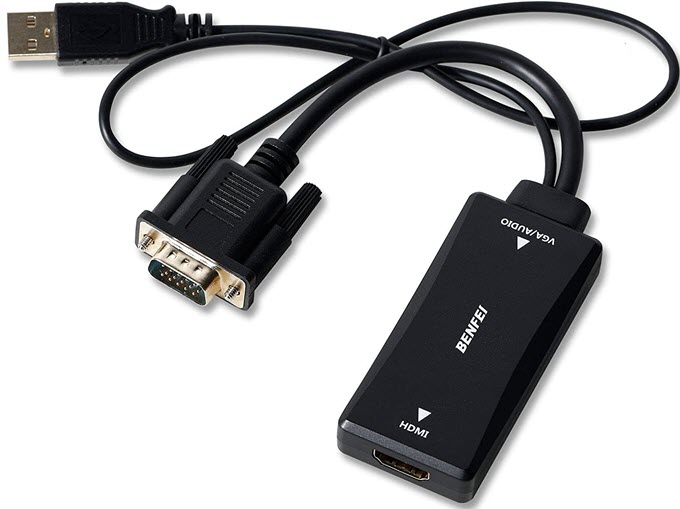
VGA to HDMI Adapter
Note: VGA connector is also called a D-Sub 15-pin connector.
VGA to HDMI Adapters you can Buy:
- Benfei VGA to HDMI Adapter with Audio Support
- FOINNEX VGA to HDMI Adapter with Audio Support
- QGeeM VGA to HDMI Adapter with Audio Support
Queries?
Selecting the right display adapter or converter cable is very important because if you make a mistake, then you will end up wasting your time and money. So, if you have any confusion regarding them, then you can ask your queries in the comment section below.
(*This post may contain affiliate links, which means I may receive a small commission if you choose to purchase through the links I provide (at no extra cost to you). Thank you for supporting the work I put into this site!)
![Best RGB RAM for Gaming PC in 2025 [DDR4 RGB Memory] Best RGB RAM for Gaming PC in 2025 [DDR4 RGB Memory]](https://graphicscardhub.com/wp-content/uploads/2018/01/rgb-ram-led-memory-211x150.jpg)

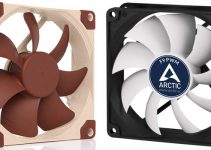
Is there seriously no to VGA adapter/cable that supports 2048×1536?
no to VGA adapter?
Oh, sorry. Looks like part of the sentence went missing:
Is there seriously no DisplayPort/HDMI/DVI to VGA adapter/cable that supports 2048×1536?
If there really is none, what is the best graphics card that still had a VGA port?
You can find GeForce GT 730 with a VGA port.
Why are newer graphics cards coming without DVI? Is DVI dead already? Now DisplayPort seems to dominate! And so called “gaming monitors” out there are with VGA, HDMI and DVI but very few have Display Port. It sucks!